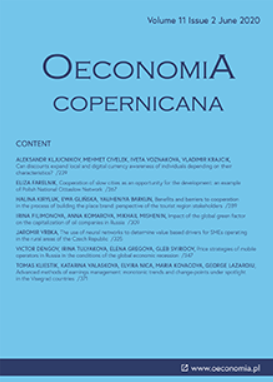New patterns in the position of CEE countries in global value chains: functional specialisation approach
New patterns in the position of CEE countries in global value chains: functional specialisation approach
Author(s): Aleksandra Kordalska, Magdalena OlczykSubject(s): Business Economy / Management, Economic policy, International relations/trade, Comparative politics
Published by: Instytut Badań Gospodarczych
Keywords: functional specialisation; gross export decomposition; occupations; economic upgrading; CEE countries;
Summary/Abstract: Research background: High servitisation of manufacturing makes it impossible to separate services from manufactured goods properly, which implies difficulties in the assessment of the position of the country on the smile curve, i.e. in the proper assignment of products or services to one of the industrial process steps: pre-production, pure fabrication or post-production services. Therefore, we propose to use the business functions of industries identified with the aid of labour market data rather than the industrial classification of products in order to create a more appropriate measure of the position of countries in GVCs. Purpose of the article: We aim to identify and analyse the patterns of functional specialisation for eight Central and Eastern European Countries (CEECs) — the Czech Republic, Estonia, Hungary, Latvia, Lithuania, Poland, Slovakia and Slovenia — both at the country and industry level. In addition, we analyse functional specialisation patterns for Germany, which serves as a reference country. Methods: To assess functional specialisation patterns, we employ the methodology proposed by Timmer et al. (2019a). It allows us to obtain functional specialisation indices for four different business functions — management, R&D, marketing, and fabrication. To compute them, we combine two sources of data — domestic value added from decomposed sectoral input-output tables (the World Input Output Database) and the Occupations Database built up by Timmer et al. (2019a). Findings & value added: Our research shows a very heterogeneous pattern in CEEC countries' position in GVCs by taking into account their functional specialisation at the countries and industries levels. Poland and Slovakia focus primarily on low value-added fabrication processes, the Baltic countries and Slovenia specialise in management services, Hungary and Latvia gain in marketing services, and the Czech Republic and Slovenia win in R&D activities. We indicate that some CEE countries (Poland, Slovakia) could be stuck in a functional trap, and our approach could be a valuable tool for assessing the process of coming out of it.
Journal: Oeconomia Copernicana
- Issue Year: 12/2021
- Issue No: 1
- Page Range: 35-52
- Page Count: 18
- Language: English

